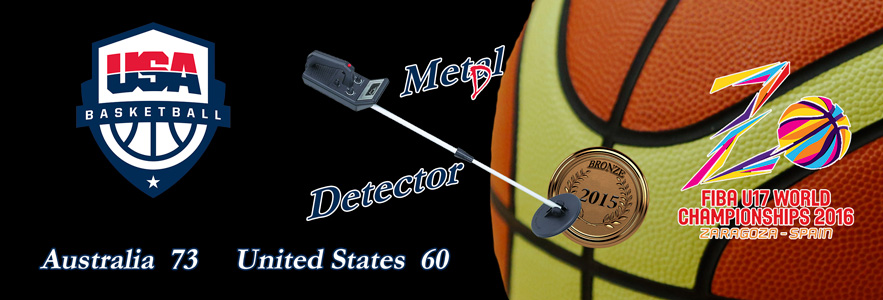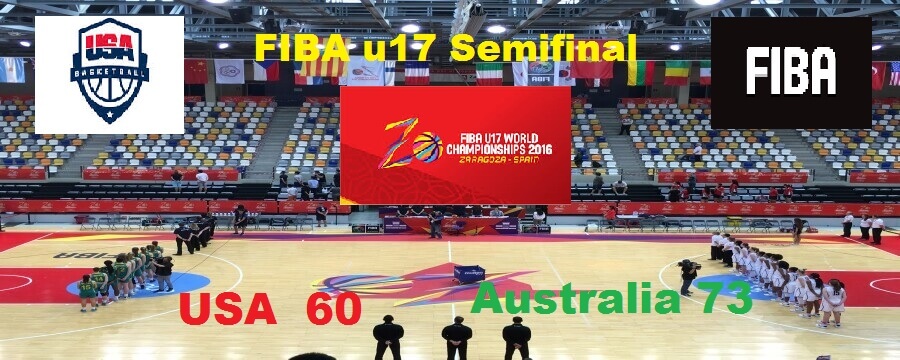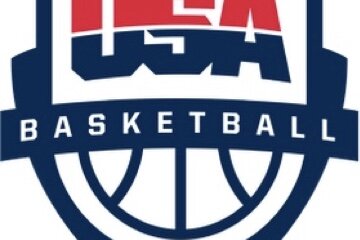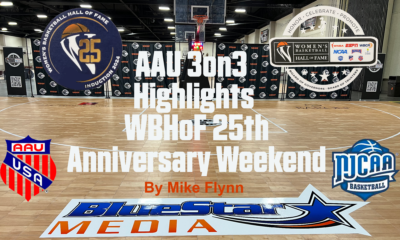 ZARAGOZA, Spain — The messages started to come by text, by twitter, twitter DM, by email and even phone calls – and it was only the second quarter of Friday evening’s FIBA u17 World Championships semifinals against Australia. The urgency being expressed was exasperation over the performance of the USA u17 team falling behind from the start and later watching Australia lead the entire game for a convincing 73-60 victory.
ZARAGOZA, Spain — The messages started to come by text, by twitter, twitter DM, by email and even phone calls – and it was only the second quarter of Friday evening’s FIBA u17 World Championships semifinals against Australia. The urgency being expressed was exasperation over the performance of the USA u17 team falling behind from the start and later watching Australia lead the entire game for a convincing 73-60 victory.
It was obvious during Thursday’s quarterfinals 30-point blowout win over Czech that Australia was big enough, conditioned and ready to take on the USA team in a showdown of the unbeaten. The key to the disciplined defense the Aussies play is 6-4 center Ezi Magbegor who collected 10 point, 10 rebounds and her backup 6-5 Lucy Cochrane (9 rebounds).

Even though Australia took the lead first it wasn’t until the second quarter when they started to open leads of 4 to 8 points with their defense which limited the USA to single shots in between turnover and tipped balls. Every opportunity to run was halted by the Australia defense.
Magbegor had all of her game points and 7 rebounds by halftime. The USA was behind nine at half, 36-27, but the game still looked like it was winnable. In the second half the USA could not put together any offensive runs despite hitting the boards for 26 offensive rebounds.
The USA tried multiple lineups and situations but the Aussie bigs were enough to challenge shots (blocking 10) and forcing turnovers (which led to 23 points) and forcing the Americans into tough 3-point shots as the 30-second clock wound down on each possession. When Australia needs points they got timely scoring from 5-9 guard Jazmine Shelley (23 points, 4 for 6 on 3-pointers, 8 rebounds) in the second half and “Debbie Black-like” pressure out front from small 5-5 point guard Monique Conti over 19 minutes for 10 points and three steals.
Everyone in the building and those back home watching the game online kept waiting for the eventual comeback, similar to what occurred in a pre-tournament “friendly” when the USA rallied down 19-points for the win. This time there was no comback and as the clock wound down Australia made it’s own history by being the first team to beat an American team in FIBA youth competition and first Aussie team to get to a FIBA youth (u17/u19) goal medal game.
The Info: The most effective American was still developing 6-4 Olivia Nelson-Ododa (Winder, GA) with 17 points, 10 rebounds in 25 minutes) and 2015 holdover 6-2 Aquira DeCosta (Stockton, CA) with 12 points and 8 rebonuds. The USA shot a dismal 1 for 14 (7%) from the three and 13 for from the line (59%) to go with 18 turnovers.
The Bronze: With the loss the USA will not be able to defend their three-time gold medal (2010, 2012, 2014) streak but are still in a medal hunt when they face a very interesting China team with 6-7 center Xu Han. China, which is having it’s best FIBA youth tournament since 2010 (bronze) by just getting to the medal round, lost to Italy 62-51 in the other FIBA u17 semifinal. This is the same Italian team that the USA beat in the Pool section of this tournament 59-55. Both Australia (5th, 2012 & 2014) and Italy (6th, 2012) have never made it to the FIBA u17 semifinals. Australia is the only undefeated team left in the event at 6-0.
The Blame: When the USA loses there’s plenty of people who’ve never been to a FIBA international youth event, nor seen any of the FIBA zone championship teams compete to complain about our “right” to win the gold every year. In women’s basketball the USA has been blessed with great talent, great tradition and great competitors unfortunately, the world is catching up.
The USA Women’s Senior National Team (Olympic team) is expected to roll when they get to Rio next month. The world at the Senior level can only challenge us. The change that the common complainer won’t see is the Youth game. I saw the shift in the women’s side back in 2003 when other teams besides the traditional powers like Russia, Australia, Brazil, and France produced talent. Now, a Russia didn’t even have a team qualify in the top five in last year’s FIBA Europe 16s. They pushed their talent into the u19s last year in Moscow where they came in second. Respect has to be given to the competition now.
For USA Women’s Basketball the pipeline is now in need of repairs. In 2014 the USA u19’s barely beat Spain for the championship. In 2015 the USA could not defend it’s title and came in third in the u16 FIBA Americas to Brazil (13th) and Canada (playing for 5th) who are were out of the medal rounds.
The 2015 Bronze medal Americas team roster was gutted this past May with only DeCosta and 6-7 Sedona Prince (Liberty Hill, TX) returning. This meant Coach Dodi Oldaker was going to Spain with practically a new team and expected to win gold with less than 30 days of practice and competition. If the 2015 Bronze team was a good summer travel squad as selected by the Developmental National Team Committee (Carol Callan, Yolanda Griffith, Bill Larson, Jody Patrick, Sherri Pegues and Jill Rankin-Schneider) the 2016 u17 team at least had more length, quickness and talent to make a deep run. The big problem was asking a fresh group to play the top teams who’ve been together for almost two years.
As said before, the coaching staff got what was given to them the past two years by the DNTC. The players were selected for 2015 and 2016 with only Rankin-Schneider actually coaching and being at any FIBA youth events besides Callan. The expectations of just wearing the USA jersey creates expectations all their own. Slippage from Spain 2014 with the u19s, to the back-to-back silver medal performances at the FIBA 3X3 the last two years losing to France and now a possible Bronze medal again, it might be time for a deep re-evaluation of the USAB women’s selection and development process – our pipeline.
No matter how the USA team finishes this year, or even last year, the biggest takeaway is that ALL the players from 2015 and 2016 will be getting college scholarships if they choose to work hard, stay healthy and play. These two teams have the singular joy of wearing the USA jersey coupled with the visibility for a scholarship – what more can a parent, family or fan ask for. Sure we all want gold. Everyone is looking for a reason for this unrealized expectation. I say look no further than the process. Our pipeline needs fixing.
FINAL NOTE: There were over 43 US college coaches in attendance, mostly head coaches here to view the USA team talent and the international teams and their talent too. Colleges are using the FIBA World Championships as a key recruiting stop as the level of fundamentals, skills and participation continues to drop in America. As one coach said, “At least these international parents aren’t calling me every minute.” Look for eventual changes to the NCAA recruiting calendar to include ALL FIBA Championships (Zone, World, 3×3) and possibly to the HS and non-scholastic calendars after that.
Mike Flynn is owner and operator of Blue Star Basketball and U.S. Junior Nationals. He is a National Evaluator and publishes the Blue Star Report which ranks the top 100 high school girls basketball players in the nation. He also serves as Secretary of the Middle Atlantic District AAU, National Chair for AAU Lacrosse, Consultant to Gatorade for girls basketball, member of the McDonald's All–American selection committee, & Consultant for Nike Global Basketball.







